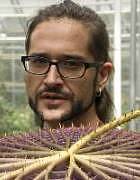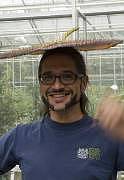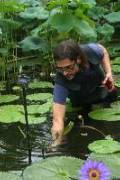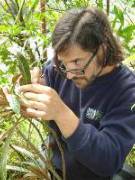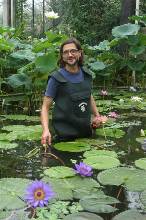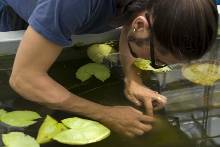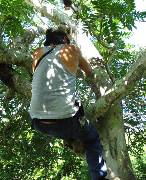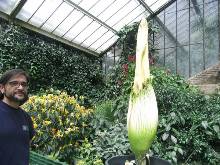|
I was born in 1972, in Gijon, Asturias, Spain. Once I say Spain, most readers will make up their minds in seconds and say, "Oh, somebody from a dry, sunny and Mediterranean location ..." Wrong. I come from a misty, moist, wet, damp, cold, cloudy, mossy, Atlantic piece of land. Not very well known, Asturias is a very unusual and yet-to-be discovered part of Europe. A range of mountains with many peaks rising to 2,600 m (8,530 ft) above sea level, 6 to 40 km (4 to 25 miles) away from the northwest Atlantic, makes this area of Spain one of the rainiest places in Europe. It may seem irrelevant, but this combination of mountain, sea and rain has created some of the greatest natural spaces in Europe, and, almost certainly, the best preserved in the European West Atlantic. To support this, I just would add that it holds the largest patch of primary deciduous forest, the last viable population of brown bear and the largest of wolf in Western Europe. Other biological jewels in the crown include the highest densities of otter, boar and chamois on the continent, the world's only capercaillie that lives in a deciduous forest, and probably the largest and healthiest population of wild salmon in South Europe. (Does it sound typically Spanish?) Floristically it's quite remarkable too, holding numerous endemic species. Due to the mountain range, it is often the south limit for some species (high in the mountains), and the north limit for Mediterranean ones (down near the coast on south facing slopes). As an example, and due to the nature of this website, I will mention Nuphar pumilla, which still grows (I hope) in a small pond, about 3 to 4 m (10 to 13 ft) wide in a bog at 2000 m (6562 feet) high in very acidic waters. This case is quite remarkable, as this small pond is its only location for the whole of the Iberian Peninsula. In fact, the nearest place to find this taxon would be the Swiss Alps or the Scandinavian countries. It may be just me, but this fact amazed me as I came across it when I was still a child. I thought it was incredible that something would have survived from the last ice age in such a tiny environment; which in fact is a bog that is almost totally full by decantation. The last second in the clock of a species that will be wiped out as the life span of a pond ends and the temperature climbs up the hill … I guess that the mix of botanical/scientific facts, combined with the desperate situation and the romantic/poetic allure created from the view of this survivor still flowering in a post-glacial pond on the top of a hill, was what created my amazement. Despite this wilderness, some parts of Asturias are amongst the more contaminated and industrialised in Europe too, so there were (and there are) other sides of the coin right on my doorstep. You can be in a totally post industrial hi-tech city and minutes later (less than and hour) you can be in a no-road, no-house-in-sight, no coverage and an "I-can-hear-the wolves-getting-closer" kind of location. |
|
Now that I have briefly described the landscape where I was
brought up, I need to describe my familiar environment. My grandfathers
were farmers in a little (29 people) village in the mountains.
They, as many other farmers in the area, were amazing in that
they were 100% self-sufficient at a moment when the word self-sufficient
did not exist yet or was still being baked. I was shown by my
grandfathers, uncles and parents how to air-layer a lemon tree,
graft an apple tree, harvest sweet corn, beans, tomatoes and
any other usual crop that you can think of. They even taught
me other activities such as making a jumper, from sheep to wearing,
making butter, jam, cider and so on. It didn't seem unusual to
me at the time, but now, living in London in 2007, I have the
feeling of travelling back in time 800 years for the weekend
and coming back My father was a sales representative. So you may think that he did not have much to do with rural landscapes, flora and nature. Wrong. He represented companies whose main clients were garden centres, as they manufactured pots, garden sculptures, hard landscape materials or imported plants from Holland, etc. Due to these facts, I was totally surrounded by plant-growing environments Monday to Friday and Friday to Monday. I had millions of plants at home or at my mother's shop during the weekdays and then went for the weekends and summers to either my grandfather's village or to my father's orchard. This was a huge piece of land that my father bought when I was about four years old. It cost him peanuts as most of it was a huge peat bog and that wasn't fashionable those days in Spain. After draining it, and adding things such as manure, sand and other compounds, we achieved two different things: first the destruction of a really rare habitat, and second an amazing soil in which during subsequent years more that 3000 fruit trees and about 3000 ornamentals were planted. |
|
During all my childhood (and up to the present day) I was fascinated by every single aspect of the natural world. Psychologists say that every child has an early development stage where it is very interested in animals and forms of life. I guess that I never overcame that stage (I may even need therapy!). I drove my family crazy by filling the house with pets, and making my room into a natural history museum. Then a ban on feathery/furry family members took place and I was allowed just to have aquariums. It was a really wrong decision; first, the ban came too late. I had too many birds, so an aviary was built up in my parents' orchard to house them which I thought was great! Now I could have ducks, geese, quails, pigeons! (Started with a pair, ended up with more than 300 ...) Second, the "just aquariums" policy led to an uncontrolled proliferation of tanks that ended up converting my room and other locations into a fish breeding factory. I wound up having any species that were available from the local markets. Next I became hooked on bird watching and I loved it! Nobody understood me. In those days, in Spain, no one was doing it and there wasn't a popular word that described the activity. So if I said, "I'm going to go to this lake, mountain or beach to look at the birds," nearly everyone thought I was crazy or would ask why and where was the fun in doing so. I started working, as a gardener or in my parents businesses. Later on I worked installing aquariums, ornamental ones at offices and public places. Others were in restaurants, to be used as a way of keeping seafood alive, which is quite typical in the gastronomy of this area of Spain. Due to my early knowledge of the natural spaces and species, occasionally I worked for the government researching the status and location of endangered species, such as capercaillie, oystercachter, chamois and others. I loved that "field research" work, but it was very unreliable, as you get employment for a month doing a project, then nothing for six months and then another project for maybe two months. You could not do this as a permanent job and I needed to alternate it with gardening and the aquarium business. Unfortunately, as I was approaching my 20s, both grandfathers died, and neither of my parents lived on the farm, so it got left behind. Then when I was about 25, my father died too and my mother retired. Somehow I felt like a stage in my life was closing and I started wondering about the possibility of working abroad for a while. Because it was spring and also that 2001 was a beautiful year to start a "space odyssey", I moved north to the UK. In May 2001 I landed in London with the aim of improving my English and staying there for six months. I was offered a job as sommelier in a four-star hotel located in a huge English historic garden. I thought it would be fun and a perfect way to improve my English. They were quite impressed with my sommelier skills (having a Spanish or French accent is a plus!), and after all, if you talk about wine, you talk about horticulture: Such variety of grape, that is harvested in this or the other way, after being grown in a chalky soils and fermented barrels of a certain tree species, the bottle being topped with a cork from Quercus suber, that is harvested after five years….it really made me learn a lot of the horticultural jargon! I was going to go home in October 2001 after spending the summer in London. Somehow, by the time September kicked in, I was working as gardener at the same hotel, and making flower arrangements! It did not take long until I was on the green side of the force! If somebody like me visits London, there is something that you cannot miss: Kew Gardens. I took the tube one day and visited the wondrous Kew. I really was not aware that that day was going to change my life for a long time. After spending a few hours in the garden, I decided that I was going to work there whatever it took. I found out that you could do three months internships in the different units/sections of the gardens. I applied for a position in the Tropical Nursery, a behind-the-scenes enormous glass house that holds a very impressive collection of plants. I started there one winter, looking after the glasshouse that holds about 700 accessions of aroids. And there was a problem, a serious one: I loved it! My three months internship was finishing and I really wanted more, so I applied for a temporary position as propagator, and a few days later for a position in the prestigious Kew Diploma in Botanical Horticulture. I went to both work interviews. The Kew Diploma one was tough. It lasted almost a whole day: interviews with an intimidating panel (four people from different departments bombarding you with questions of all sorts), practical exams, etc. After a few days I got the news: I got both, the temporary position, so I could just carry on after my internship; and the Kew Diploma too, which started two days after I finished my temporary contract. I had read about the Kew Diploma in a Spanish gardening encyclopedia when I was 11 years old and the last thing I was thinking when I read it was that I would end up joining it when I was 29. Life and its spins … |
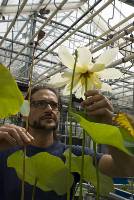 |
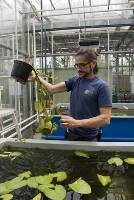 |
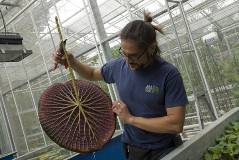 In the nursery with << Nelumbo, < N. violacea and ^ V. 'Adventure' |
WGI ONLINE Journal 2-3
Cover Story: Carlos Magdalena Revitalizes the Aquatics Collection at RBG Kew
Also in the issue
The Mauritius Report
A detailed account of this extraordinary repatriation project
and
Dan Leighton Looks After Kew's Water Lily House
What he does, how he does it and how he explains it to Kew's guests
